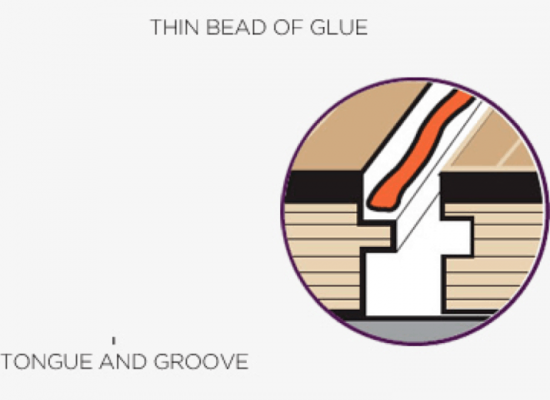
- Wear Layer: this is the surface of the wood that’s able to be sanded in the future. Thicker wear layers are always recommended.
- Core: the core is what provides the extra stability in engineered wood flooring.
- Solid Flooring: solid flooring is milled from a piece of timber.
SOLID WOOD FLOORING
Solid flooring is just like it sounds, a solid piece of wood that is milled from a single piece of timber. Solid wood floors are generally 3/4″ thick and come in widths ranging from 1.5″ to 12″. Because of the thickness, a solid floor can be refinished several times over generations of use. Solid floors are nailed down to either a plywood or OSB subfloor on or above grade. In certain cases solid wood floors can be installed over radiant heating and over concrete (with proper subfloor preparation).
ENGINEERED WOOD FLOORING
Engineered hardwood is produced with 3-10 layers of hardwood that are cross stacked and bonded together under heat & pressure. As a result, engineered flooring is less likely to be affected by changes in humidity and they’re able to avoid many of the more common issues that can arise with solid floors including; issues related to solid wood floors being a wide plank and issues arising from temperature + humidity swings. Engineered wood floors can be purchased unfinished or prefinished. It’s a very common misconception that engineered floors are cheaper than unfinished, this is not the case. Actually, engineered wood floors cost more then solid due to them requiring more steps in the manufacturing process. If you found an engineered floor that is cheaper then it’s solid counterpart, more then likely it’s a sub par product. You can’t go cheap with engineered floors because it will mean sacrificing the thickness of the product and of the wear layer. In many cases, this can mean that the floors can’t be refinished in the future, meaning that when they get worn they’ll need to be completely replaced.
UNFINISHED
Unfinished flooring come direct from the mill with no finish, stain or sealer. These floors are sanded and finished on site.. Both Solid & Engineered Wood Floors are available in unfinished. Most of our clients prefer unfinished flooring because the floors become one uniform, very well sealed surface. Other benefits include; unlimited color and finish options. Ease of future repairs if needed (since we’ll know what was used on it), moldings & vents blending in to the floor better, floors finished onsite are less likely to be effects by spills (since the entire surface is sealed over). Unfinished wood floors are our specialty and our preferred floor type due to the countless benefits of them vs prefinished floors. It’s a constant struggle for us to educate our potential clients of these benefits because in many cases they are being told just the opposite from other retailers and installers. The reason that others say just the opposite is they are usually talking to people that don’t own the expensive equipment to sand the floors, or they lack the knowledge in the true art of floor finishing.
PREFINISHED
Pre finished flooring comes direct from the factory already stained, sealed and with the finish applied. Both solid and engineered floors come prefinished. These floors only need to be installed onsite and require no sanding onsite. Prefinished floors are generally more expensive to buy than unfinished floors. However, the labor is a less since no sanding and finishing needs to be done on site. The main benefit of prefinished floors is projects can be done faster than with site finished. Prefinished floors will be more difficult to refinish in the future due to the micro bevel and the sealers and finishes used by the manufacturers. Pre finished floors are also more susceptible to water damage in the event of a leak because water can seep into the bevels where the wood is not sealed.
NAIL DOWN
Nail down wood floors are just as they sound “nailed down”. This is the most common installation method for solid prefinished & unfinished hardwoods. Many engineered wood floors can also be installed with a nail down method when the proper subflooring is in place.

GLUE DOWN
Glued down wood floors are also just as they sound; glued down. This is the most common method for installing engineered wood floors over concrete or gypcrete. Glue down is also often used in combination with nail down when installing wider planked flooring of 5″ or larger as it helps with stability in wider planks.

FLOATING
Floating wood floors are those that are installed without being attached to the subfloor. Instead these floors are attached to themselves. Most commonly these are attached by gluing together the tongue & groove of the flooring. Floating wood floors are most commonly installed in condos (where sound requirements exist), over concrete, or when being installed below grade (as the underlayment used under floating floors, creates a barrier from moisture). We try to avoid floating floors whenever possible, as glue or stapling is always the better option in our professional opinion.

